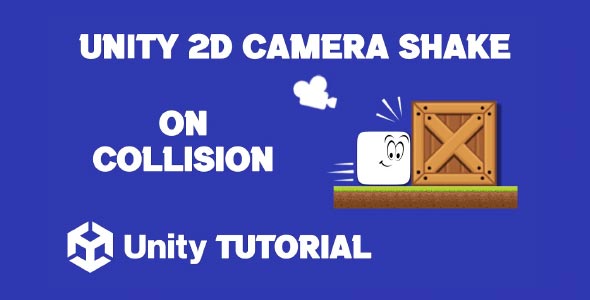Unity 2D camera shake tutorial is one of the most searched topics among developers who want to enhance the feel and responsiveness of their 2D games. Whether you’re working on an action-packed shooter or a pixel art platformer, camera shake adds an impactful, dynamic element to your gameplay. When used properly, it can bring a sense of weight, urgency, and immersion that’s hard to achieve with static visuals alone.
This guide will walk you through why camera shake is effective, how it’s commonly used, and how to implement it smoothly into your Unity 2D projects. You don’t need to be an expert to follow along, just a working knowledge of Unity and a desire to improve the player’s visual experience.
The Power Of Camera Shake In 2D Games
Adding a shake to your camera may seem like a small visual tweak, but the impact it can have on gameplay is huge. Camera shake simulates the physical feedback players expect when something intense happens in the game world, such as an explosion, a heavy landing, or a dramatic moment.
This is particularly effective in 2D games, where the camera is often static or only follows a character. A bit of movement during specific events makes the world feel more alive. From recoil effects in shooting games to crash impacts in driving levels, shake can serve both gameplay and aesthetic purposes.
Developers often overlook subtle polish features like camera shake, but they’re one of the easiest ways to make a game feel more responsive. The key is knowing how to integrate it without overdoing it, which is exactly what this camera shake tutorial aims to help you achieve.
Unity Camera Shake Effect And Player Immersion
The Unity camera shake effect has become a staple in modern game development. It provides immediate visual feedback that something powerful or meaningful has occurred. This enhances immersion and helps guide the player’s emotional response.
Imagine your character fires a powerful weapon or takes damage from a massive boss attack. Without camera shake, the event might feel flat or unremarkable. But with even a short burst of shaking, the moment feels heavier and more dramatic. It cues the player to react differently, creating a stronger connection between their actions and the game’s visual world.
Camera shake is also useful for non-combat situations. For example, when a large door slams shut or a platform crumbles beneath the player, adding shake amplifies the tension and stakes. In puzzle games, it can signify a correct or incorrect move with satisfying impact.
How To Add Camera Shake In Unity 2D Game The Right Way
Understanding how to add camera shake in Unity 2D game is a straightforward process, but getting it to feel “right” often takes some trial and error. The goal is to apply the shake at the correct moments and with appropriate intensity.
The camera should move quickly, randomly, and return smoothly to its original position. Too much shake, or poorly timed shake, can disorient players or even make the game harder to play. On the other hand, a subtle, short duration shake can be incredibly satisfying.
To achieve balance, many developers categorize shakes by intensity: light (like footsteps), medium (weapon recoil), and heavy (explosions or boss attacks). Applying different intensities based on the in-game event keeps the experience engaging without being overwhelming.
Once you understand the timing and feel, it’s easy to reuse and customize the shake across different game events. This ensures consistency while still allowing creative expression in your visual feedback design.
When And Where To Use Shake Effect
While adding camera shake is a powerful tool, it’s most effective when used sparingly and intentionally. Overuse can lead to visual noise or fatigue, especially in fast paced games where too much screen movement becomes distracting. Following a clear Unity 2D camera shake tutorial makes it easier to find that sweet spot where the effect feels impactful without becoming a distraction.
The best moments to apply camera shake include:
-
Combat feedback: Shooting, getting hit, explosions, or melee impacts
-
Environmental cues: Earthquakes, falling objects, crumbling structures
-
Transitions and cutscenes: Emphasizing dramatic moments or changes
-
Player actions: Landing from a jump, dashing, or activating abilities
Each of these moments is enhanced when the camera momentarily reacts to the action. The brief movement adds life to otherwise flat or repetitive scenes and helps guide the player’s focus toward important game events.
A polished shake also pairs well with other visual effects, such as screen flashes, particle bursts, and sound effects. Together, they form a more complete feedback loop that increases player satisfaction.
Enhancing Feedback With Camera Shake UI Unity
Integrating the Unity camera shake effect into your game is more than just a cosmetic decision, it’s part of building a satisfying feedback system. Modern players expect polished visuals and responsive design, and camera shake plays a subtle but crucial role in achieving that.
When players feel their actions are being acknowledged by the game, it improves engagement. The sense of physical presence, even in a flat 2D world, helps deepen immersion. Shake adds texture to the gameplay without requiring new art or assets, making it a cost effective way to enhance quality. Mastering how to add camera shake in Unity 2D game lets you seamlessly incorporate this effect and boost your game’s overall feedback.
You can even get creative with your shake implementation. For example, some developers vary the direction of the shake based on the source of the impact. A hit from the right might push the camera left, while an explosion might cause a more chaotic pattern. This kind of contextual feedback adds a professional layer to your presentation.
Customizing Camera Shake
After learning how to add camera shake, customization is the next step. Not all shake is created equal, and adjusting the intensity, duration, and frequency will help you fine-tune the effect to your specific art style and gameplay pacing.
Lighter shake works well in pixel art or minimalist games, where too much movement can feel out of place. In more visually intense games, you might use exaggerated shake to emphasize chaos or power. Your game’s genre and visual design will largely guide how dramatic or subtle your camera movement should be.
Another tip is to link shake strength to gameplay metrics. For example, a stronger enemy attack can trigger a heavier shake, while weaker attacks result in milder feedback. This gives players intuitive, non verbal cues about the power or impact of various actions.
You can also experiment with combining shake intensity with other game variables, like player health or power-ups, to create more dynamic and responsive visuals that evolve with the gameplay.
Conclusion
Using camera shake in your 2D game is one of the simplest ways to increase visual impact without overhauling your art or animations. As this Unity 2D camera shake tutorial has shown, a well timed shake can elevate gameplay moments from ordinary to memorable. It adds weight, emotion, and responsiveness, all of which make your game feel more polished and enjoyable.
The Unity camera shake effect isn’t just a flashy add on; it’s a crucial part of a broader feedback system that helps players feel connected to the game world. Whether you’re developing a combat heavy title or a story driven experience, using shake sparingly and purposefully will go a long way in refining player engagement.
Once you understand how to add camera shake in Unity 2D game, you can start tailoring the effect to your unique needs. Whether you’re enhancing jump landings, triggering dramatic cutscenes, or amplifying combat, camera shake is a tool you’ll return to time and again. Use it wisely, and your game will not only look better, it will feel better too.
Scripts: CameraShake.cs
using UnityEngine;
public class CameraShake : MonoBehaviour
{
private float shakeDuration = 0f; // Ensure this starts at 0
public float shakeMagnitude = 0.1f;
public float dampingSpeed = 1f;
private Vector3 originalPosition;
void Awake()
{
originalPosition = transform.position;
}
void Update()
{
if (shakeDuration > 0)
{
// Apply shake effect
transform.position = originalPosition + Random.insideUnitSphere * shakeMagnitude;
// Decrease shake duration
shakeDuration -= Time.deltaTime * dampingSpeed;
// Reset position when duration ends
if (shakeDuration <= 0)
{
shakeDuration = 0f;
transform.position = originalPosition;
}
}
}
public void TriggerShake(float duration, float magnitude)
{
shakeDuration = duration;
shakeMagnitude = magnitude;
}
}Script: PlayerCollision.cs
using UnityEngine;
public class PlayerCollision : MonoBehaviour
{
public CameraShake cameraShake;
public float shakeDuration = 0.2f;
public float shakeMagnitude = 0.2f;
void OnCollisionEnter2D(Collision2D collision)
{
if (collision.gameObject.CompareTag("Collider"))
{
if (collision.relativeVelocity.magnitude > 1) // Adjust threshold if needed
{
cameraShake.TriggerShake(shakeDuration, shakeMagnitude);
}
}
}
}Camera shake is a great way to add impact and intensity to events like explosions, damage, or environmental effects in a 2D game. By slightly adjusting the camera’s position over time, you can create a sense of force or disruption. If you’re also working with 3D projects or want to see how shake effects are handled in a different context, this Shake Camera Unity 3D tutorial provides a helpful look at implementing similar effects in a three dimensional environment.


